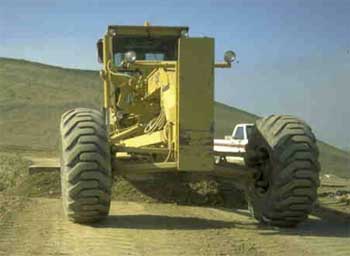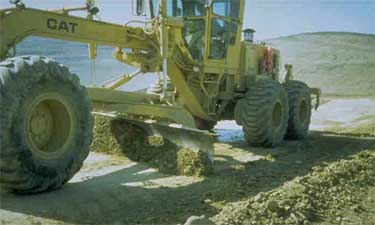Bolton on Landfill Management: Use that grader!
If your image of a motor grader is limited to a lonely, slow-moving machine on out on some rural, county road, wake up and smell the coffee. Turn that motor grader loose and let it flex its muscles. You might just be surprised at what it can do.
By Neal Bolton, principal,
Blue Ridge Services
Contents
Maintaining vehicle access roads
Constructing/cleaning ditches
Tipping pads
Maintaining the scraper's haul roads
Sloping
Cover soil maintenance
Snow/mud removal
Many landfills have motor graders in their equipment fleet. That's good.
Many of the landfills that have motor graders aren't using them to their full capacity. That's bad.
Motor grader, motor patrol, grader, or blade. No matter what you call it, it's a machine that can be difficult for operators to master. Yet it may be even more difficult for managers to fully recognize its capabilities. Buying a motor grader and then using it only for smoothing the vehicle access roads is like buying an Apache Attack Helicopter, and then using it to shoot seagulls at the landfill. Although if you've tried everything else to solve your bird control problem, this might sound pretty good!
But the point is motor graders are incredibly versatile machines. And, while keeping the main access road smooth and well-graded is important, if you're limiting the grader to that task, you're limiting yourself too. Motor graders can also be used for general haul road maintenance, particularly for the scraper's haul road.

Additionally, most motor graders have the ability to articulate and side-shift (extend) the blade. This makes the graders very useful for trimming cut and fill slopes on roads or in excavation areas. And, because of its long wheelbase, it can do very delicate, fine grading. It is the finish grading machine on most road-building, grading, and ditching projects.

Here are some ideas to help you get more out of your motor grader.
Maintaining vehicle access roads
The roads that provide access for commercial and private waste haulers must be kept in good condition. They must drain well and be of adequate width and slope to allow vehicles to safely pass each other. This not only makes the road safer, but increases its service life too. This is one of a grader's primary tasks at the landfill. (Back to top)
Constructing/cleaning ditches
With their ability to tilt, rotate and side-shift the moldboard, motor graders are ideal for constructing and maintaining ditches. Under the right conditions, a grader can remove weeds from, and re-establish the flowline of, a ditch, better than any other machine. (Back to top)
Tipping pads
Again, the grader is the premier finishing machine. If it's got to be smooth, use a grader. Whether it's making subgrade, spreading gravel, or dressing up the truck's unloading area, the grader can do a quick and efficient job.
Don't be fooled by the grader's ability to do delicate finish work. When it comes to construction, the grader is no sissy! (Back to top)
Maintaining the scraper's haul roads
If you want to haul dirt, get a scraper or an excavator and some trucks. If you want to haul dirt cheap and fast, get a motor grader. When it comes to hauling dirt, production boils down to payload and cycle time. Regular use of a motor grader to keep the haul road smooth is the most important step toward fast cycle times. (Back to top)
Sloping
When a new road is constructed, it's not finished until the cut-slope is trimmed and smooth. Again, we look to the grader to do this work. By side-shifting the moldboard, the grader can trim the slope while keeping its wheels on the roadbed. The grader is unique in its ability to do work on awkward, hard to reach slopes, while the machine remains steady and stable. (Back to top)
Cover soil maintenance
Daily and intermediate cover soil requires periodic maintenance. At most landfills, cover maintenance is performed by the dozer. Yet, in many cases, the grader could do the job faster and better.
By starting at one edge and drifting a small windrow of soil across (with each subsequent pass), the grader can make those covered decks and slopes look like new. However, as you might expect, the grader is limited to fairly flat slopes (i.e., 3:1 or flatter). (Back to top)
Snow/mud removal
Most landfills have seasonal problems with mud and/or snow. Here again, in terms of road maintenance, the grader is made to order. A few passes up and back and most roads can be cleaned off and ready for traffic.
If traction is a problem, consider using snow chains on the grader. Chaining up the grader will provide good traction not just on snow or ice, but in muddy conditions too. Some landfills that never see snow keep a set of chains handy ...just for working in mud. Keep in mind that it's not just the rear (driving) tires that must be chained up, but the front tires too. Otherwise, the grader won't steer.
If your image of a motor grader is limited to a lonely, slow-moving machine on out on some rural, county road, wake up and smell the coffee. Turn that motor grader loose and let it flex its muscles. You might just be surprised at what it can do. (Back to top)
Coming up on Solid Waste.com: In the next few articles, we'll begin a series that looks at some specific grader tasks in more detail.
About the author: Neal Bolton, a registered engineer, author of "The Handbook of Landfill Operations," and principal of Blue Ridge Services, provides operational consulting for landfills in the U.S. and abroad. He can be reached at blueridge@blueridgeservices.com.
(Back)
